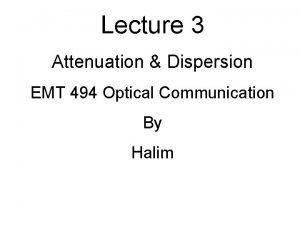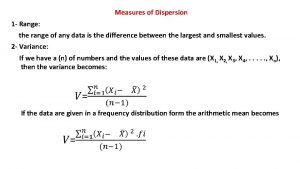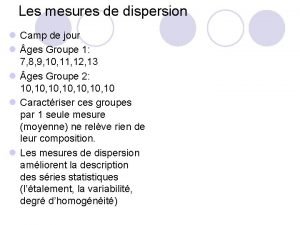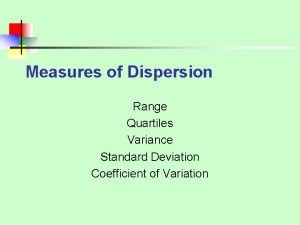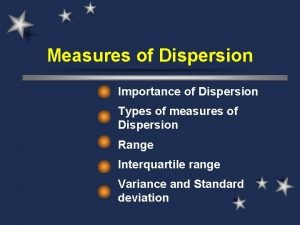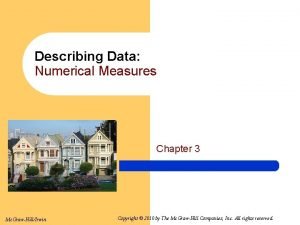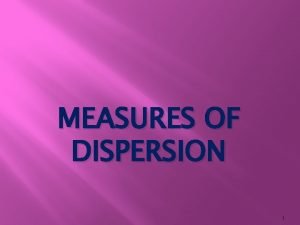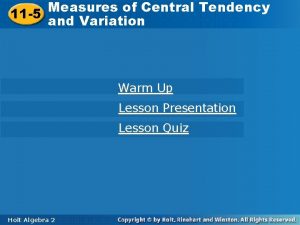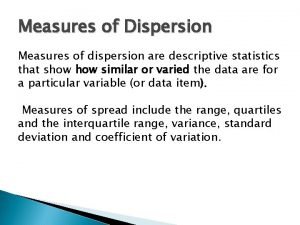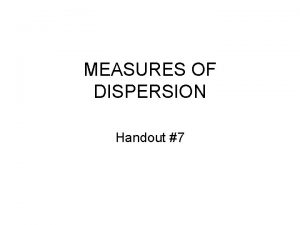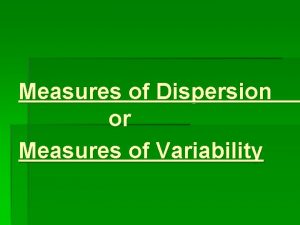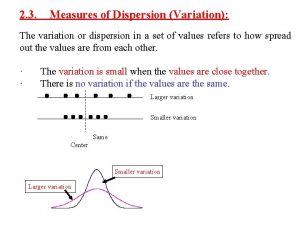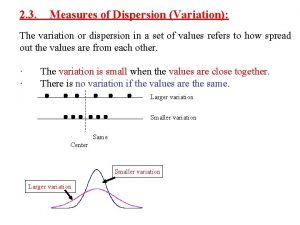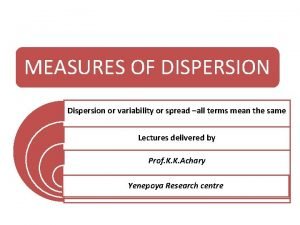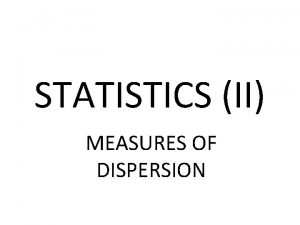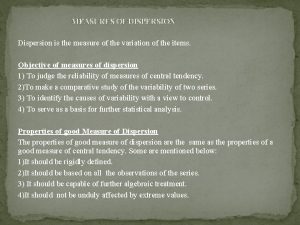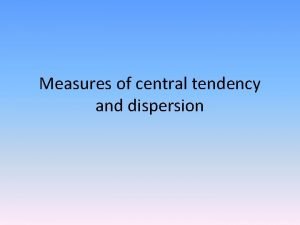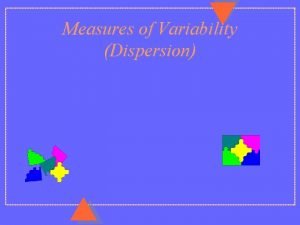2 3 Measures of Dispersion Variation The variation














- Slides: 14

2. 3. Measures of Dispersion (Variation): The variation or dispersion in a set of values refers to how spread out the values are from each other. · The variation is small when the values are close together. · There is no variation if the values are the same. Larger variation Smaller variation · Same Center Smaller variation Larger variation

Some measures of dispersion: Range – Variance – Standard deviation Coefficient of variation Range: Range is the difference between the largest (Max) and smallest (Min) values. Range = Max Min Example: Find the range for the sample values: 26, 25, 35, 27, 29. Solution: Range = 35 25 = 10 (unit) Note: The range is not useful as a measure of the variation since it only takes into account two of the values. (it is not good)

Variance: The variance is a measure that uses the mean as a point of reference · The variance is small when all values are close to the mean. · The variance is large when all values are spread out from the mean Squared deviations from the mean: X 1 X 2 Xn (X 1 )2 (X 2 )2 (Xn )2 (1) Population variance: Let be the population values. The population variance is defined by:

(unit)2 where is the population mean. Notes: · is a parameter because it is obtained from the population values (it is unknown in general). · (2) Sample Variance: Let be the sample values. The sample variance is defined by: (unit)2

Where is the sample mean Notes: · S 2 is a statistic because it is obtained from the sample values (it is known). · S 2 is used to approximate (estimate) . · Example: We want to compute the sample variance of the following sample values: 10, 21, 33, 54. Solution: n=5

(unit)

Another method: 10 21 33 53 54 -24. 2 -13. 2 -1. 2 18. 8 19. 8 Calculating Formula for S 2: * Simple * More accurate 585. 64 174. 24 1. 44 353. 44 392. 04

Note: To calculate S 2 we need: · n = sample size · The sum of the values · The sum of the squared values For the above example: 10 21 100 441 33 53 54 1089 2809 2916 (unit)2 Standard Deviation: · The standard deviation is another measure of variation. · It is the square root of the variance.

(1) Population standard deviation is: (2) Sample standard deviation is: (unit) Example: For the previous example, the sample standard deviation is (unit) Coefficient of Variation (C. V. ): · The variance and the standard deviation are useful as measures of variation of the values of a single variable for a single population (or sample). · If we want to compare the variation of two variables we cannot use the variance or the standard deviation because: 1. The variables might have different units. 2. The variables might have different means.

· We need a measure of the relative variation that will not depend on either the units or on how large the values are. This measure is the coefficient of variation (C. V. ) which is defined by: (free of unit or unit less) Mean St. dev. C. V. 1 st data set 2 nd data set · The relative variability in the 1 st data set is larger than the relative variability in the 2 nd data set if C. V 1> C. V 2 (and vice versa).

Example: 1 st data set: 2 nd data set: 66 kg, 4. 5 kg 36 kg, 4. 5 kg Since , the relative variability in the 2 nd data set is larger than the relative variability in the 1 st data set. Notes: (Some properties of , S, and S 2: Sample values are : a and b are constants

Sample Data Absolute value: Sample mean Sample st. dev. Sample Variance

Example: (1) (2) (3) Sample mean Sample St. . dev. Sample Variance C. V. 1, 3, 5 3 2 4 66. 7% -2, -6, -10 11, 13, 15 8, 4, 0 -6 13 4 4 2 4 16 66. 7% 15. 4% 100% Data (1) (2) (a = 2) (b = 10) (3) (a = 2, b = 10)

Can C. V. exceed 100%? Data: 10, 1, 1, 0 Mean=3 Variance=22 STDEV=4. 6904 C. V. =156. 3%
 In which type of fibers intermodel dispersion loss occurs
In which type of fibers intermodel dispersion loss occurs Dispersion phase and dispersion medium
Dispersion phase and dispersion medium Protective colloid
Protective colloid Range measures of dispersion
Range measures of dispersion Measures of dispersion
Measures of dispersion Measures of dispersion definition
Measures of dispersion definition Among 420 randomly selected employees
Among 420 randomly selected employees Mean, median, mode formula for grouped data
Mean, median, mode formula for grouped data Measures of dispersion range
Measures of dispersion range Discuss the importance of measures of dispersion
Discuss the importance of measures of dispersion Variance of grouped data
Variance of grouped data Measures of dispersion
Measures of dispersion Define measures of dispersion
Define measures of dispersion Anova repeated measures
Anova repeated measures Measures of central tendency and variation
Measures of central tendency and variation
